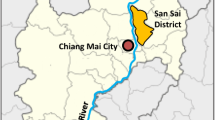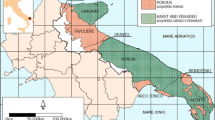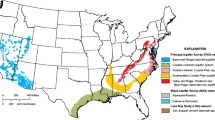Abstract
The effects of two methods of septic tank effluent disposal on the microbial quality of alluvial gravel aquifers were investigated at an experimental site in the Canterbury Plains, New Zealand. The movement of faecal coliform bacteria 9 m from a 5.5 m deep soakage pit into an unconfined aquifer, and 42 m from an 18 m deep injection bore into a confined aquifer was recorded. Partial sealing of the soakage pit sidewalls was evident, but approximately 80% of the effluent appeared to percolate rapidly into the unconfined groundwater through a permeable pathway in the unsaturated zone. There was evidence of groundwater mounding beneath the soakage pit and around the injection bore and the consequent radial spread of leachate from both disposal structures. In both the confined and unconfined aquifers, the most heavily contaminated bores exhibited marked diurnal fluctuations in faecal coliform concentrations in response to periods of effluent discharge. First arrival velocities of a rifampycin-resistantEscherichia coli tracer of approximately 15 m day−1 in the unconfined groundwater and 151 m day−1 in the confined groundwater were recorded. Implications of the findings for the monitoring and management of groundwater quality beneath unsewered communities on alluvial gravel formations are briefly discussed.
Similar content being viewed by others
References
American Public Health Association, American Water Works Association and Water Pollution Control Federation: 1980,Standard Methods for the Examination of Waters and Wastewater, 15th edition. American Public Health Association.
Ayrey, R. B. and Noonan, M. J.: 1983, in M. J. Noonan (ed.),Microbiology and Water Quality, Proc. Joint Conf. N.Z. Committee Water Poll. Res. and N.Z. Micro. Soc., Tech. Pub. 3, Department of Agricultural Microbiology, Lincoln College, Lincoln, N.Z. p. 69.
Barnett, B. G. and Simons, P. K.: 1980,Septic Tank Discharges in Hawkes Bay, Internal Report, Hawkes Bay Catchment Board and Regional Water Board, Napier, N.Z.
Bouma, J., Ziebell, W. A., Walther, W. G., Olcott, P. G., McCoy, E., and Hole, F. D.: 1972,Soil Absorbtion of Septic Tank Effluent, University of Wisconsin Extension Circular No. 20. Madison, Wisconsin.
Canter, L. and Knox, R. C.: 1984,Evaluation of Septic Tank System Effects on Ground Water Quality, National Center for Groundwater Research, Norman, Oklahoma, PB 84-244441.
Crane, S. R. and Moore, J. A.: 1984,Water, Air, and Soil Pollut. 22, 67.
Fielding, M. B.: 1982, inProceedings of the Third National Symposium on Individual and Small Community Sewage Treatment, Am. Soc. Agric. Engr. Pub. 1–82.
Finnemore, E. J. and Hantzsche, N. N.: 1983,J. Irrig. and Drain. Div. Am. Soc. Civil Eng. 109, 199.
Gunn, I. W.: 1974,N. Z. Sanitarian, Sept. 1974, 61.
Hagedorn, C., McCoy, E. L., and Rahe, T. M.: 1981,J. Environ. Qual. 10, 1.
Hantush, M. S.: 1967,Water Resources Res. 3, 227.
Keely, G. M. and Quin, B. F.: 1979:Progress in Water Technology 11, 369.
McGauhey, P. H. and Winneburger, J. H.: 1964,J. Water Poll. Cont. Fed. 36, 539.
Martin, G. N. and Noonan, M. J.: 1977,Water and Soil Tech. Pub. 7. Ministry of Works and Development, Wellington, N.Z.
New Zealand Standards Institute: 1961,New Zealand Standard Specification for Household Septic Tanks (NZSS 758:1961), Hutcheson, Bowman and Stewart Ltd., Wellington, New Zealand.
Otis, R. J. and Boyle, W. C.: 1976,J. Environ. Engr. Div. Am. Soc. Civil Eng. 102, 175.
Sinton, L. W.: 1980a,Water and Soil Tech. Pub. 17. Ministry of Works and Development, Wellington, N.Z.
Sinton, L. W.: 1980b,J. Hydrol. (NZ) 19, 119.
Sinton, L. W.: 1982,NZ J. Marine and Freshwater Res. 16, 317.
Sinton, L. W. and Close, M. E.: 1983,Pub. 2 of the Christchurch Hydrology Centre. Ministry of Works and Development, Christchurch, N.Z.
Thorpe, H. R., Burden, R. J. and Scott, D. M.: 1982,Water and Soil Tech. Pub. 24. Ministry of Works and Development, Wellington, N.Z.
Tyler, E. J., Laak, R., McCoy, E., and Sandhu, S. S.: 1977, inHome Sewage Disposal, Am. Soc. Agric. Eng. Pub. Proc. 5–77. p. 22.
Viraraghavan, T. and Warnock, R. G.: 1974, ‘Treatment Through Soil of Septic Tank Effluent’, inProc. International Conference on Land for Waste Management, Le Droit, Ottawa, Canada. p. 214.
Wilson, J. L. and Miller, P. J.: 1978,J. Hydraul. Div. Proc. Am. Soc. Civil Eng. 104, 503.
World Health Organization: 1971,International Standards for Drinking Water, Third Edition, World Health Organisation, Geneva.
Ziebell, W. A., Nero, D. H., Deininger, J. F., and McCoy, E.: 1974, inHome Sewage Disposal, Proc. Nat. Home Sewage Disposal Syrup. Am. Soc. Agric. Engr., St. Joseph. Michigan, p. 9.
Author information
Authors and Affiliations
Rights and permissions
About this article
Cite this article
Sinton, L.W. Microbial contamination of alluvial gravel aquifers by septic tank effluent. Water Air Soil Pollut 28, 407–425 (1986). https://doi.org/10.1007/BF00583504
Received:
Revised:
Issue Date:
DOI: https://doi.org/10.1007/BF00583504




